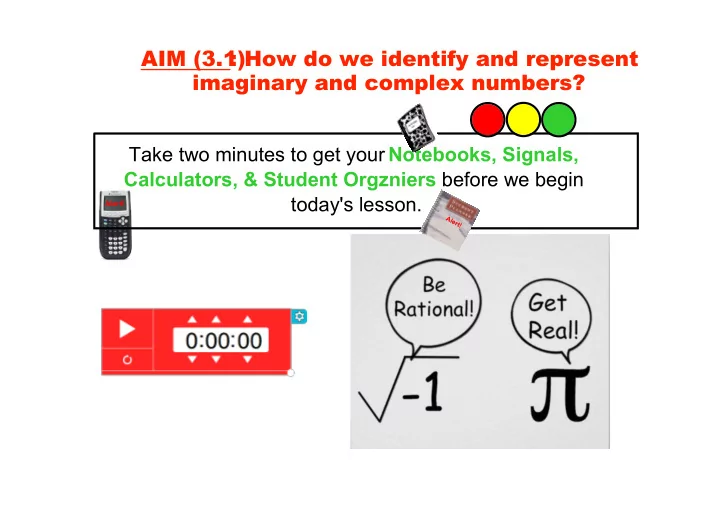

AIM (3.1) : How do we identify and represent imaginary and complex numbers? Take two minutes to get your Notebooks, Signals, Calculators, & Student Orgzniers before we begin today's lesson. Alert! Alert!
Aim 3.1: How do we identify and represent imaginary and complex numbers? HW: Worksheet 3.1, all EVEN problems Alert! DoNow Begins! Simplify each radical expression. Make sure your final answer has no negative terms in the radicand (underneath the radical sign). 3) 4) 2) 1)
Aim 3.1: How do we identify and represent imaginary and complex numbers? HW: Worksheet 3.1, all EVEN problems 3) 4) 1) 2)
Announcements : A l e r t ! 1) (Optional) DeltaMath assignment : Review #3 , due Friday. (Every 10 questions complete = +2 on Midterm Exam.) 2) Tutoring : Mr. Lo is available after school Monday & Friday : Right after school 3) MACS Robotics club does not meet this Wednesday (Halloween)
Aim 3.1: How do we identify and represent imaginary and complex numbers? HW: Worksheet 3.1, all EVEN problems What are Imaginary Numbers for? Used for : Signal Processing (Cellphone signals), Electricity (AC & DC Waves), Quadratics (when parabolas don't touch the xaxis)
Aim 3.1: How do we identify and represent imaginary and complex numbers? HW: Worksheet 3.1, all EVEN problems Imaginary Number A number that is expressed in terms of the square root of a negative number (usually the square root of −1, represented by i ). The Imaginary Unit The imaginary unit, i , is the number whose square root is equal to negative 1.
Aim 3.1: How do we identify and represent imaginary and complex numbers? HW: Worksheet 3.1, all EVEN problems Simplifying Radicals with Negatives A radical is not considered simplified if there is a negative radicand. Ex. 1 Ex. 2 Ex. 4 Ex. 3
Aim 3.1: How do we identify and represent imaginary and complex numbers? HW: Worksheet 3.1, all EVEN problems Simplify each negative radical expression. Ex. 5 Ex. 6
Aim 3.1: How do we identify and represent imaginary and complex numbers? HW: Worksheet 3.1, all EVEN problems Simplify each negative radical expression. Ex. 5 Ex. 6 One Both Neither Correct Correct Correct
Aim 3.1: How do we identify and represent imaginary and complex numbers? HW: Worksheet 3.1, all EVEN problems What do you notice about the answers when taking an even vs. an odd root of a negative number? Ex. 5 Ex. 6 Disuss with Your Neighbor
Aim 3.1: How do we identify and represent imaginary and complex numbers? HW: Worksheet 3.1, all EVEN problems Roots of Negative Numbers EVEN INDEXES: If the radicand is negative, the roots are imaginary only if the index is EVEN. ODD INDEXES: If the radicand is negative, the roots are real and negative.
Aim 3.1: How do we identify and represent imaginary and complex numbers? HW: Worksheet 3.1, all EVEN problems What is the imaginary unit and when do we use it to simplify expressions?
Aim 3.1: How do we identify and represent imaginary and complex numbers? HW: Worksheet 3.1, all EVEN problems Simplifying Square Roots with Negative Radicands Assess as You Work I got it! 1 2 I don't get it 3 I'm not sure
Aim 3.1: How do we identify and represent imaginary and complex numbers? HW: Worksheet 3.1, all EVEN problems 4 6 7 8 0 3 Correct Correct Correct
Aim 3.1: How do we identify and represent imaginary and complex numbers? HW: Worksheet 3.1, all EVEN problems Complex Number Any number that can be written in the form "a + b i " where a and b are real numbers. Ex. 3 + 2 i , 4 + i , 5 2 i *All numbers can be written as a complex number. Ex. 7 i = 3 =
Aim 3.1: How do we identify and represent imaginary and complex numbers? HW: Worksheet 3.1, all EVEN problems Adding & Subtracting Complex Numbers Ex. 1 Ex. 2
Recommend
More recommend